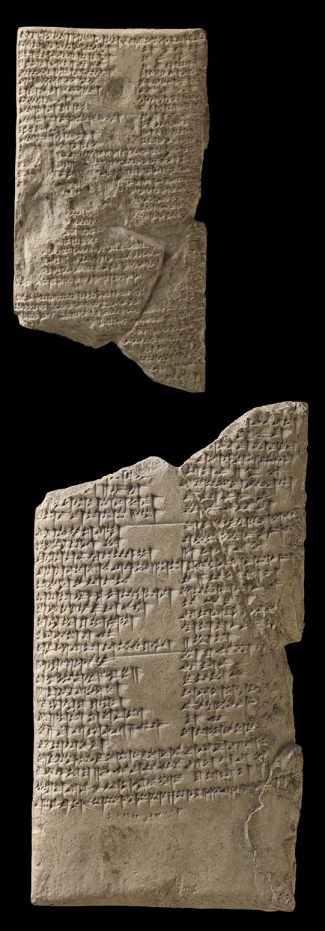Old Babylonian Lament: The Man and His God

This lament is found on one tablet, AO 4462, housed in the Louvre in Paris. It was first edited and published in handcopy by Jean Nougayrol in 1952 (see →bibliography). Von Soden offered several early improvements to the reading of the text. See von Soden 1957: 315-319 (→bibliography). W. G. Lambert published a much improved edition of the text in the Reiner Festschrift (→library). See Lambert 1987 (→bibliography). Other translations include Foster 2005: 852-856 (English) and von Soden 1990: 135-140 (German). For this text's record and treatment at the Sources of Early Akkadian Literature project, see here (Gabbay and Wasserman 2008). For its CDLI:wiki page, which requires updating, see here. For a very interesting and useful exposition of the text using insights from medical anthropology, see Zisa 2012.
Following the rulings on the tablet, von Soden 1957: 316-319 lays out the poetic structure: The lament falls into nine strophes each containing ten poetic lines (though not always written on ten lines). Strophe 1 = obv. 1-9 (with obv. 1 containing two poetic lines); Strophe 2 = obv. 10-16 (with obv. 14-16 containing two poetic lines); Strophe 3 = obv. 17-21 (with each containing two poetic lines); Strophe 4 = obv. 22-26 (with each containing two poetic lines); Strophe 5 = obv. 27-31 (with each containing two poetic lines); Strophe 6 = obv. 32-38 (too damaged to determine poetic lineation); Strophe 7 = rev. 1-9 (with rev. 5 maybe containing two poetic lines); Strophe 8 = rev. 10-19 (with each containing one poetic line); Strophe 9 = rev. 20-29 (with each containing one poetic line). Rev. 30-31 is a colophon. Lambert suggests that the ten line strophes may not have been a poetic device; rather, the scribe may have simply marked every decade of poetic lines with a ruling (1987: 188-189). Thematically, the text follows a different structure. With Lambert (1987: 189), the text may be outlined as follows: Obv. 1-11 form the opening narrative, the setting. Obv. 12 and following form a first person lament, which turns into an account of restoration beginning in obv. 32. By rev. 4 or 5, third person narrative is clearly discernible again. Rev. 10-29 (strophes 8-9) contain the personal god's direct speech to the supplicant. Lambert does not identify the function of rev. 30 but it seems to be the copyist's prayer (named in rev. 31).
Following the rulings on the tablet, von Soden 1957: 316-319 lays out the poetic structure: The lament falls into nine strophes each containing ten poetic lines (though not always written on ten lines). Strophe 1 = obv. 1-9 (with obv. 1 containing two poetic lines); Strophe 2 = obv. 10-16 (with obv. 14-16 containing two poetic lines); Strophe 3 = obv. 17-21 (with each containing two poetic lines); Strophe 4 = obv. 22-26 (with each containing two poetic lines); Strophe 5 = obv. 27-31 (with each containing two poetic lines); Strophe 6 = obv. 32-38 (too damaged to determine poetic lineation); Strophe 7 = rev. 1-9 (with rev. 5 maybe containing two poetic lines); Strophe 8 = rev. 10-19 (with each containing one poetic line); Strophe 9 = rev. 20-29 (with each containing one poetic line). Rev. 30-31 is a colophon. Lambert suggests that the ten line strophes may not have been a poetic device; rather, the scribe may have simply marked every decade of poetic lines with a ruling (1987: 188-189). Thematically, the text follows a different structure. With Lambert (1987: 189), the text may be outlined as follows: Obv. 1-11 form the opening narrative, the setting. Obv. 12 and following form a first person lament, which turns into an account of restoration beginning in obv. 32. By rev. 4 or 5, third person narrative is clearly discernible again. Rev. 10-29 (strophes 8-9) contain the personal god's direct speech to the supplicant. Lambert does not identify the function of rev. 30 but it seems to be the copyist's prayer (named in rev. 31).

